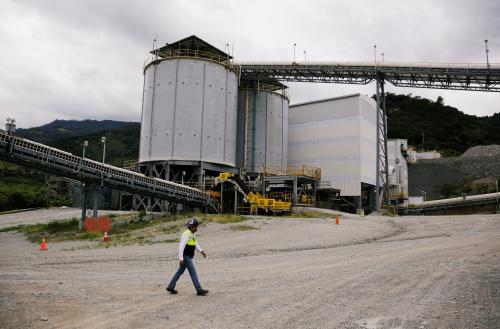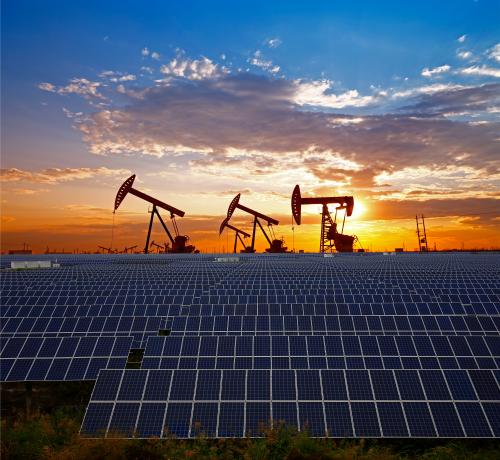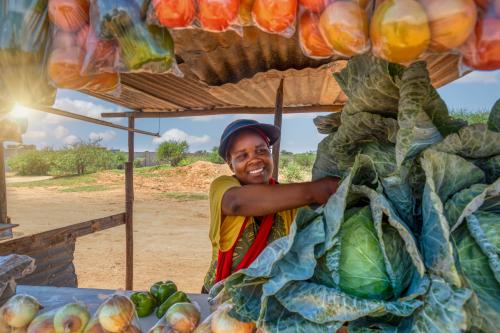Around the world, carbon emissions are falling, polluted skies are clearing, and the price of a barrel of oil has dipped below $0 for the first time ever as demand falls amid the coronavirus pandemic. Although these gains may appear to be a temporary reprieve for a global climate in urgent need of deep cuts in carbon emissions, many have noted that global fossil fuel dependence has not been significantly impacted and current emissions reductions are not likely to continue. Meanwhile, among developing countries whose economies depend on the extractive industries of oil, gas, and mining, steep declines in government revenue could entail significant social, economic, and political fallout.
The full impact of the coronavirus crisis on global extractive industries—a highly lucrative sector that generated approximately $6.4 trillion in revenue in 2019—remains to be seen. However, the plummet in demand coupled with the risk of infectious-disease outbreaks has already caused extractives projects in Mexico, South Africa, Peru, and elsewhere to be delayed, cancelled, restructured, or closed down. The environmental hazards of extractive industries—including pollution, threats to biodiversity, greenhouse gas emissions, and land degradation—are well known. However, with these and other environmental impacts come a set of corruption risks throughout the resource-extraction process, and less revenue does not necessarily equate to less corruption: in fact, it may mean the opposite. Though corruption risks can be more difficult to perceive than environmental damage itself, the former in resource production can significantly worsen environmental impacts. Today, on World Environment Day—and in the days to come—it is important to understand the ways in which corruption is entangled with environmental devastation, and so work to mitigate their impact.
Grand corruption—in which laws and regulations themselves are shaped by corrupt actors who benefit from them—can have grave consequences for environmental protection. Take the example of Honduras. As Sarah Chayes has detailed, many of the country’s largest business interests, including mining, have direct connections to the highest levels of government and rely on weak environmental regulations to operate profitably. The government, in turn, placed these companies at the center of its development strategy, and provides them with continual support in spite of widespread environmental degradation. For example, a controversial project to dam Honduras’ Patuca River was approved by the country’s environment ministry; later, an independent environmental assessment deemed the project to have “critical gaps” that would be “very hard to correct” and cause permanent damage to the land. The project went ahead anyway, leading to deforestation throughout protected environmental land.
Even when regulations are strong on paper, they can be ineffectively and corruptly enforced, which undermines all ensuing environmental protections. At the national level, officials have been known to accept or ask for bribes to issue licenses that open up land for extraction that would otherwise remain environmentally protected. At the local level, corruption can take such forms as demanding bribes from companies to waive regulatory requirements and otherwise enforcing legal requirements in an ad hoc fashion based on kickbacks. Local governments in resource-extracting regions are often underfunded and lack the staffing and technical capacity to properly enforce environmental regulations, which creates severe enforcement problems and spawns corruption risks. For instance, in Indonesia in 2011, it was estimated that one district’s health and safety offices possessed only enough resources to evaluate 25% of its 285 coal mines. Lacking the ability to adequately enforce environmental protections across the board, local officials are incentivized to do so in a highly discretionary manner, with companies seeking to limit environmental inspections and enforcement actions by paying out bribes. This form of corruption can worsen pre-existing government-capacity challenges by interrupting institution-building processes that could lead to better governance, and by undermining public trust in government.
Unfortunately, the immediately negative environmental impacts of resource production are most often felt by local communities, with extraction itself usually taking place in remote locations with weak state-enforcement capacities. As a result, even when environmental safeguards are put in place, ineffective monitoring can render them toothless. This can be seen in the case of environmental impact assessments (EIAs), which examine the anticipated environmental impact of a project before it has begun, and which are usually required before extractives permits are issued. Monitoring of EIAs is critical because some companies resist compliance with the regulations that form the basis of the EIA, and extractive projects can often overshoot EIA impact projections even when companies are compliant. Unfortunately, some governments have taken deliberate steps to reduce EIA oversight. For instance, following the recent adoption of “flexibilized” environmental rules and tightened deadlines for EIA review in Peru, no EIAs of major extractive projects were assessed by responsible government bodies.
Finally, a severe environmental corruption risk surrounding extractive projects centers around threats and violence against environmental defenders—local activists and community members who mobilize against environmental harms from resource extraction. Because resource-extraction projects typically occur in relatively isolated regions with weak state presence, communities often have few mechanisms at their disposal other than protest and disobedience to demand changes to those environmental practices that threaten their lives and livelihoods. However, some companies exploit this weak state presence to intimidate or threaten locals who question their activities. In Mongolia, for example, heavy dust kicked up by mining trucks in the predominantly rural province of Dornogovi caused land degradation and endangered the health of local people and livestock. In 2017, company representatives were caught on camera intimidating herders and journalists. Psychological pressure tactics against environmental defenders, including threats toward and defamation against those who stand up against extractive companies, remain common in Mongolia and throughout the world.
Governments, for their part, can be unresponsive to local demands or intervene on behalf of companies by surveilling activists or restricting protest activity. In the most extreme cases, tensions between locals and companies escalate to direct violence against environmental defenders. Such cases often involve webs of corruption that implicate a multitude of actors—including public officials, companies, security forces, and sometimes organized-crime networks—that each hold a stake in the profits of silencing local opposition. Often the perpetrators of such violence remain unidentified. In 2018 alone, at least 30 environmental activists in the Philippines were murdered by members of paramilitary groups and unknown assailants. At least 164 environmental defenders were murdered worldwide.
While resource extraction has slowed around the world, environmental challenges—and the corruption that exacerbates them—remain as potent as ever. To confront these challenges, it is necessary to clearly understand these environmental corruption risks and the devastating impacts they wreak across the world—throughout the pandemic and beyond.
The Brookings Institution is committed to quality, independence, and impact.
We are supported by a diverse array of funders. In line with our values and policies, each Brookings publication represents the sole views of its author(s).





Commentary
Corruption is a threat to planet Earth
June 5, 2020
Environmental corruption can have grave consequences.